The Ultimate Guide to Guest Blogging That Works: How I Got on Entrepreneur, Adweek, The Balance and Other Top Publications
 Guest blogging for major media outlets - an effort at building thought-leadership, can be intimidating. But when done right, the benefits far outweigh the pain.
Marketers understand, more than anyone else, the value of attention. But it's much more important to be seen on a platform that is trusted and authoritative. This is what guest blogging brings you. The benefits are often understated, with entrepreneurs like myself going on to build credibility, establish trustworthiness with prospects, and grow an audience while building useful relationships along the way.
There's an art to getting published in high-authority publications. This, I have learnt from years of getting myself, and my clients, published on some of the biggest publications in the world -- including on outlets like:
Entrepreneur.com
Guest blogging for major media outlets - an effort at building thought-leadership, can be intimidating. But when done right, the benefits far outweigh the pain.
Marketers understand, more than anyone else, the value of attention. But it's much more important to be seen on a platform that is trusted and authoritative. This is what guest blogging brings you. The benefits are often understated, with entrepreneurs like myself going on to build credibility, establish trustworthiness with prospects, and grow an audience while building useful relationships along the way.
There's an art to getting published in high-authority publications. This, I have learnt from years of getting myself, and my clients, published on some of the biggest publications in the world -- including on outlets like:
Entrepreneur.com
 Adweek
Adweek
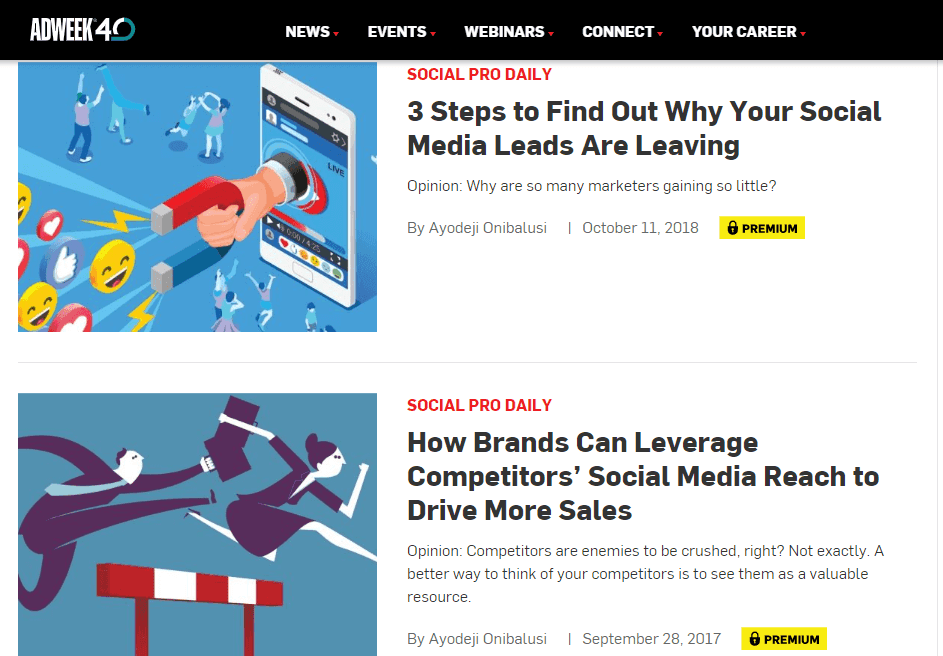 The Balance
The Balance
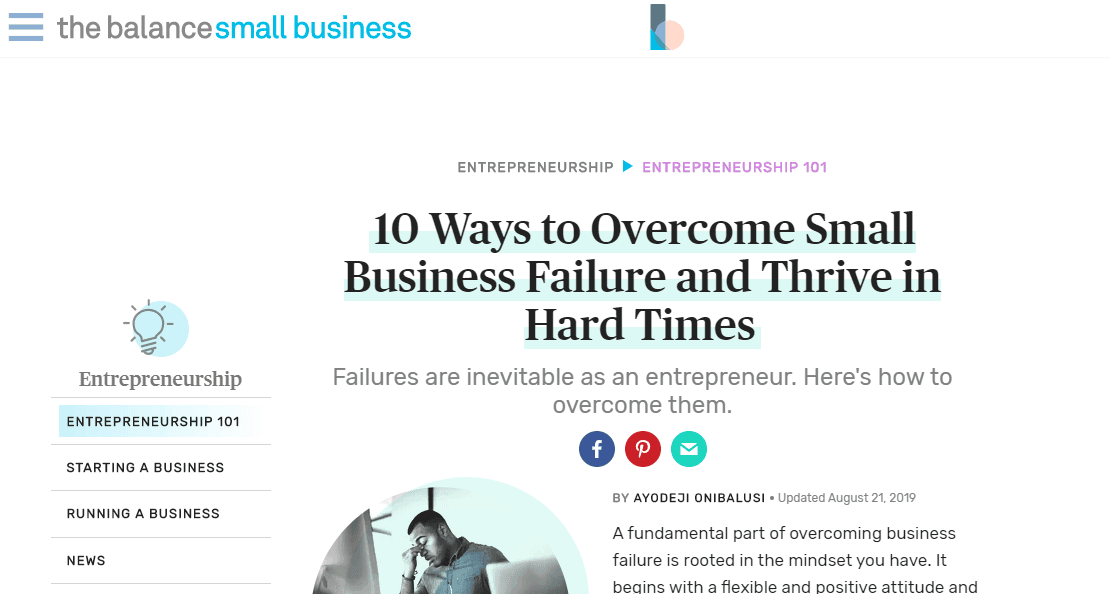 … and other major publications.
To help you replicate my success and promote your business effectively on the Internet, I'll outline in this article the process that have been the most effective for me.
… and other major publications.
To help you replicate my success and promote your business effectively on the Internet, I'll outline in this article the process that have been the most effective for me.
The Ultimate Guide to Guest Blogging that Works by @ayoonis via @CoSchedule
Click To TweetDOWNLOAD: Three Guest Blogging Templates
Make pitching guest blog posts easier with these three templates:- Email Pitch Template: Make sure every pitch is crisp, clear, and compelling.
- Guest Blog Post Pitching Checklist: Ensure you don't miss a step in the process.
- Guest Blogging Target Template: Maintain contact information and track your success when pitching top publications.
What Makes Guest Blogging So Valuable?
"It's more powerful than marketers think. B2B marketers and salespeople significantly underestimate the impact of thought leadership on demand generation and sales efforts compared to actual feedback from B2B buyers." - Edelman. Guest blogging is one of the most effective strategies marketers have used to establish thought-leadership. And for the sake of covering a broader spectrum of the marketing landscape, I'll often refer to guest blogging as thought-leadership contextually within this article. However, to avoid confusion, both can be used interchangeably. Edelman, in partnership with LinkedIn, developed a study that looked into the impact of thought-leadership on revenue for B2B brands. Their findings revealed that marketers have continued to downplay the impact of thought-leadership on revenue. The study surveyed 1,300 B2B professionals on LinkedIn -- with participants ranging from managers to CEOs. It was reported that through guest blogging, executives were able to build authority, warm up their brands to potential partners by attracting "invitation to bid (RFPs)" and earn buyer preference through earned trust. This, the study revealed, contributed to wins and even impacts pricing. The study also found positive correlation between thought-leadership and key long-term marketing goals such as customer retention.Why Using Guest Blogging to Establish Thought-Leadership is a Smart Move
I strongly believe that guest blogging is the smartest way to establish thought-leadership for the following reasons:- It is within the reach of everybody. Regardless of the size of your business or your years of experience, provided you are able to contribute valuable content, it is possible to contribute to practically any publication.
- You have a lot more control of your guest posts. I’ll know. I’ve written for Entrepreneur, Adweek, and several other notable publications. It wouldn’t have been as easy to get these publications to reach out to me and quote me, or feature me otherwise, in their content. In a lot of cases, you can determine where and when you want to be featured with guest blogging.
- There is a multiplier effect to guest blogging; the more guest posts you do, and the more authoritative blogs involved, the easier it becomes for you to get your guest posts published. Mentioning that I have been published on some of the biggest blogs makes it a lot easier for me to get published on even bigger ones.
- It helps you gain trust in your niche a lot faster, which translates to better conversions from users. In a B2B Trends report by LinkedIn, among B2B marketers, about 50 percent agree that thought-leadership content builds trust in their organization. However, with real life buyers, the figure is as high as 83 percent.

How To Optimize The Value Of you Guest Blogging Efforts
We've seen the many benefits of guest blogging but it is just as important to realize that you’ll only get results from guest blogging if your guest blogging efforts are well-optimized. To ensure successful guest blogging, your approach should go beyond simply finding the right publication for your blog. Instead, your guest blogging efforts should be built on the back of your content marketing goals. Such goals may include:- Building brand awareness: Thought leadership content marketing is a low-cost, yet effective inbound marketing strategy that brands can use to create awareness.
- Instilling confidence in leadership: A 2017 HBR report finds that 63 percent of global citizens admit that CEOs are not all or somewhat credible. A different report reveals that 83 percent of people believe that thought-leadership content builds trust in an organization.
- Generating sales: Sales in the B2B world is a complex cycle. Trust, perception and authority of the partner has a lot of sway in purchasing decisions. The Edelman thought-leadership report earlier referenced found that 39 percent of B2B decision makers and C-level executives admit that thought-leadership content influenced them to make an RFP to a vendor while 47 percent said guest blogging content was directly instrumental in awarding a contract.
- Generating direct traffic and digital marketing dividends: Search traffic has been reported as the most qualified ready-to-buy traffic for businesses. Yet, a lot of experts believe guest blogging would be used for other efforts rather than SEO. In an expert round-up on guest blogging I did that involved 39 experts, 90 percent of the respondents agreed that guest blogging would be used to generate quality traffic and build brand dividends.
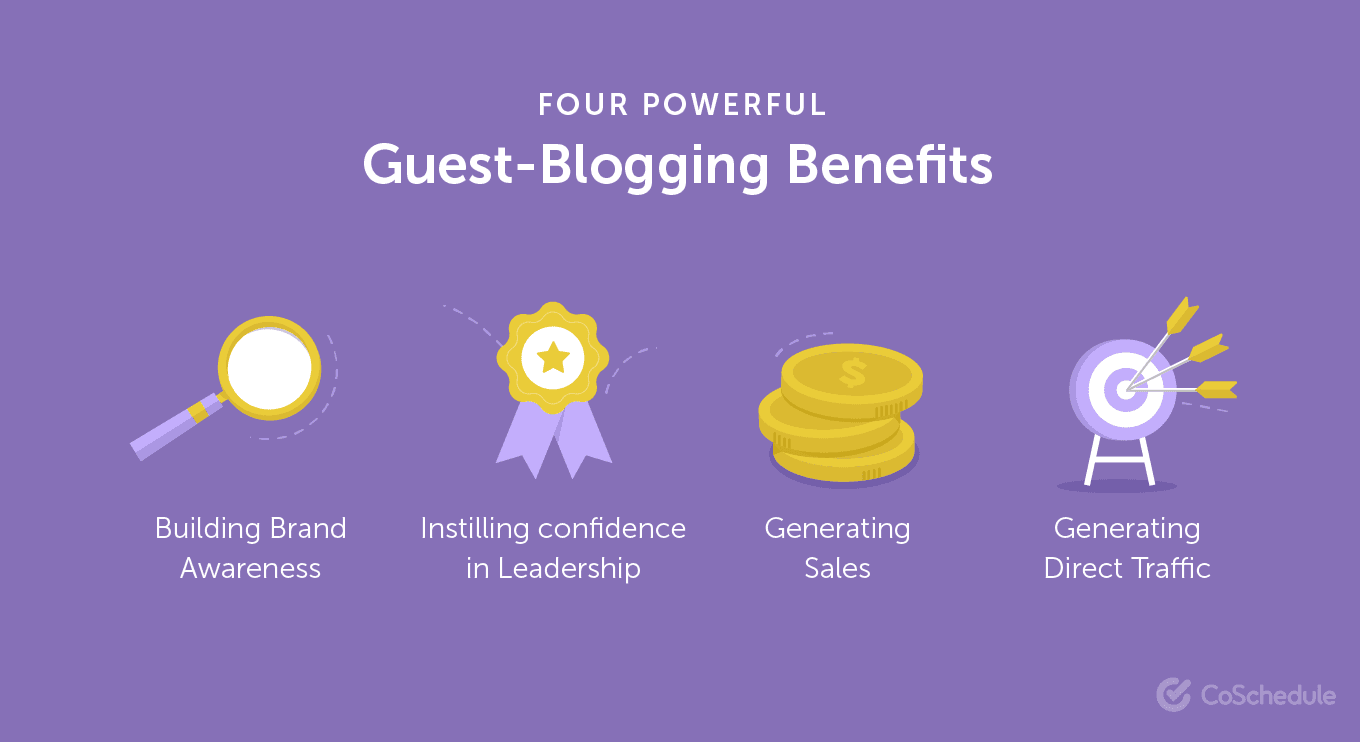 As I explained above, I believe you will only get true value from your guest blogging efforts if it is integrated with your overall content marketing strategy. Guest blogging in a vacuum rarely works.
That said, if you’re eager for the real action, I use the following four-step process for guest blogging:
As I explained above, I believe you will only get true value from your guest blogging efforts if it is integrated with your overall content marketing strategy. Guest blogging in a vacuum rarely works.
That said, if you’re eager for the real action, I use the following four-step process for guest blogging:
Step 1. Finding Blogs and Publications to Write For
This article won’t be restricted to just “blogs” in the most basic terms (since guest blogging has evolved beyond getting published on just “blogs”). Research shows that there are almost 2 billion websites in the world. So whether it is blogs, publications, magazines, or other types of websites, there are more than enough publications than you will need. However, it is important to note that not all these publications are suitable for you. There is a process for finding (and filtering) blogs that align with your guest blogging goals. The very first step towards a successful guest blogging campaign is to find the right blogs and publications. This can be done in two key ways:1. Find and Filter Blogs by Niche and Domain Metrics
Like I said earlier, there are almost 2 billion websites in the world: the vast majority of these websites aren’t publications that will take guest posts or are in a completely irrelevant niche. One of the very first steps you want to take is to filter down to a list of blogs, publications, and websites that are relevant to your niche. You can do this in two ways:- Create a list of blogs and websites that are in the exact same niche as your business. If you sell cameras, for example, this will be photography blogs.
- Create a list of blogs and websites that are not directly in your niche, but are authoritative enough and can be tied to your niche. If you sell cameras, you could still guest post on a blog about creatives, personal development, or a blog about gadgets.
2. Find and Filter Blogs by Their Guest Blogging Policy
Once you’ve filtered blogs by niche, the next step is to filter them by their guest blogging policy. This is quite basic:- Blogs that have guest blogging guidelines.
- Blogs that do not have guest blogging guidelines.
Method #1: Using Google to Find Guest Blogging Opportunities
Using Google to find blogs that allow guest posts is quite simple. You want to come up with a list of terms that indicate guest blogging and then use in combination with your niche. These include terms such as:- write for us
- submit guest post
- guest blogging guidelines
- guest blogging
- guest posting
- submit articles
 Or photography + "submit guest post". In which case we have the following:
Or photography + "submit guest post". In which case we have the following:
 As you can see both searches present complete different options, and the possibility is just endless.
Like I said, you don’t want to restrict yourself to blogs directly in your niche (depending on your goal) or simply to “blogs.” You can find relevant, authoritative publications outside of your niche that will still contribute to your end result. Entrepreneur.com and Huffington Post aren’t about inbound marketing (which is what my business is about), yet being published in these places have been highly beneficial for my brand.
You can also use Ahrefs to do the same. Ahrefs has an added advantage of allowing you to filter down blogs based on their authority. Using Ahrefs domain ratings (DR) feature, you can filter down your list of blogs to blogs that are more authoritative.
As you can see both searches present complete different options, and the possibility is just endless.
Like I said, you don’t want to restrict yourself to blogs directly in your niche (depending on your goal) or simply to “blogs.” You can find relevant, authoritative publications outside of your niche that will still contribute to your end result. Entrepreneur.com and Huffington Post aren’t about inbound marketing (which is what my business is about), yet being published in these places have been highly beneficial for my brand.
You can also use Ahrefs to do the same. Ahrefs has an added advantage of allowing you to filter down blogs based on their authority. Using Ahrefs domain ratings (DR) feature, you can filter down your list of blogs to blogs that are more authoritative.
Method 2: Using Ahrefs to Find Guest Blogging Opportunities:
Ahrefs indexes and analyzes millions of pages daily. From these pages are hundreds of thousands of high-quality blogs and publications that are actively looking for guest authors to contribute to their blog sections. The Ahrefs feature we are particular about right now is its “Content Explorer.” Using Content Explorer, you want to perform a search for the keyword most relevant to the topic of the blogs you're interested in writing about. This will show you results with a list of blogs and publications that are covering the topics relevant to this keywords.
Here is a search for blogs that have written anything about video marketing, for example:
Using Content Explorer, you want to perform a search for the keyword most relevant to the topic of the blogs you're interested in writing about. This will show you results with a list of blogs and publications that are covering the topics relevant to this keywords.
Here is a search for blogs that have written anything about video marketing, for example:
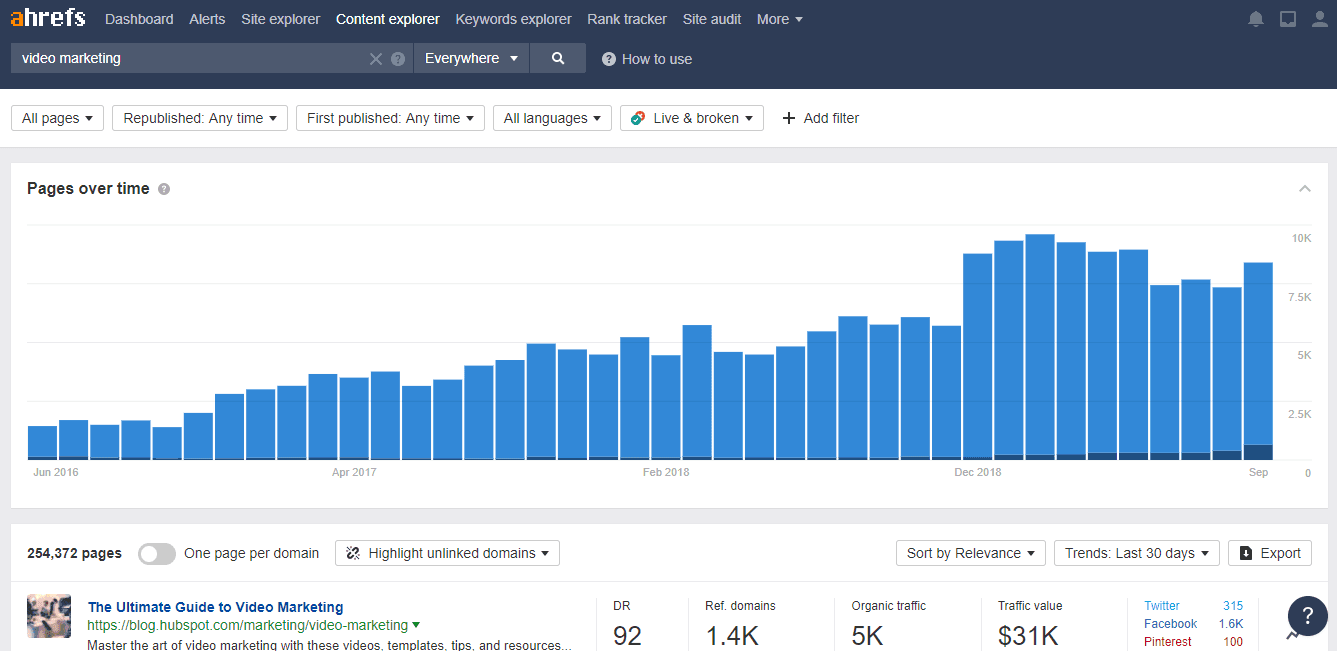 As you can see, that’s over 254,000 results!
The good thing about using Ahrefs is that, unlike with Google, it shows you more accurate results; for example, Google might claim to have 500,000 results but you realize there are only 20 pages when you start digging in. This isn’t the case with Ahrefs.
Content Explorer’s magic, however, lies in its advance filters. You can filter the results by a host of factors. This include:
As you can see, that’s over 254,000 results!
The good thing about using Ahrefs is that, unlike with Google, it shows you more accurate results; for example, Google might claim to have 500,000 results but you realize there are only 20 pages when you start digging in. This isn’t the case with Ahrefs.
Content Explorer’s magic, however, lies in its advance filters. You can filter the results by a host of factors. This include:
- By a website’s domain ratings
- By when content was first published/republished
- By language
- By whether a site is live or broken
- By the author of an article
- By the number of words
- By the number of social shares, referring domains, and traffic no/value
- All pages set to “published once.” In other words, I want the actual publish date of a piece of content. Not when it was republished.
- First published set to “this year.” I only want content that was published this year as that signifies that a blog is more active.
- All languages set to “English.” I don’t speak Spanish, or Russian ;)
- Live & Broken set to “Live.” I have no interest in guest blogging for dead publications.
- More importantly, I want to turn on the “one page per domain” toggle. It doesn’t help to be getting results from multiple domain names in the same list.
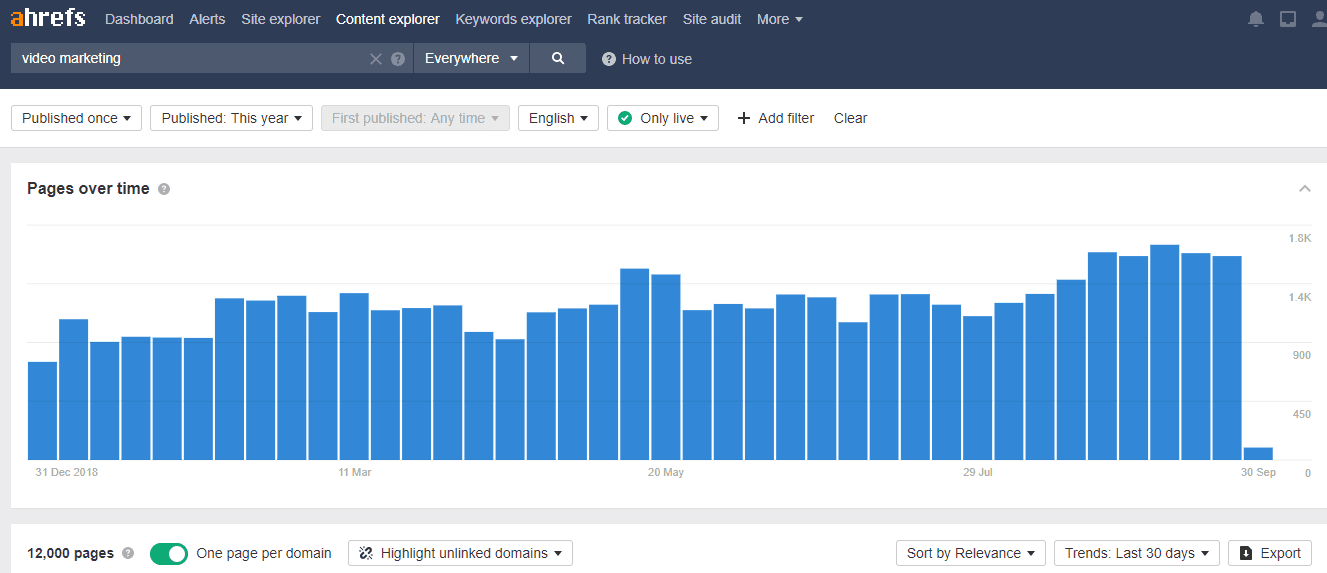 Now, the results have been massively whittled down; from over 250,000 results, I now have 12,000 publications that have written anything about my target term “video marketing.”
The next step involves a bit of manual labor: I go through those results individually and then manually review the publications to see if they accept guest posts.
To save time and make the effort worth my while, I might also add a filter by the Domain Ratings (DR) of a publication. Using the same video marketing search, I might target publications with a minimum DR of 50:
Now, the results have been massively whittled down; from over 250,000 results, I now have 12,000 publications that have written anything about my target term “video marketing.”
The next step involves a bit of manual labor: I go through those results individually and then manually review the publications to see if they accept guest posts.
To save time and make the effort worth my while, I might also add a filter by the Domain Ratings (DR) of a publication. Using the same video marketing search, I might target publications with a minimum DR of 50:
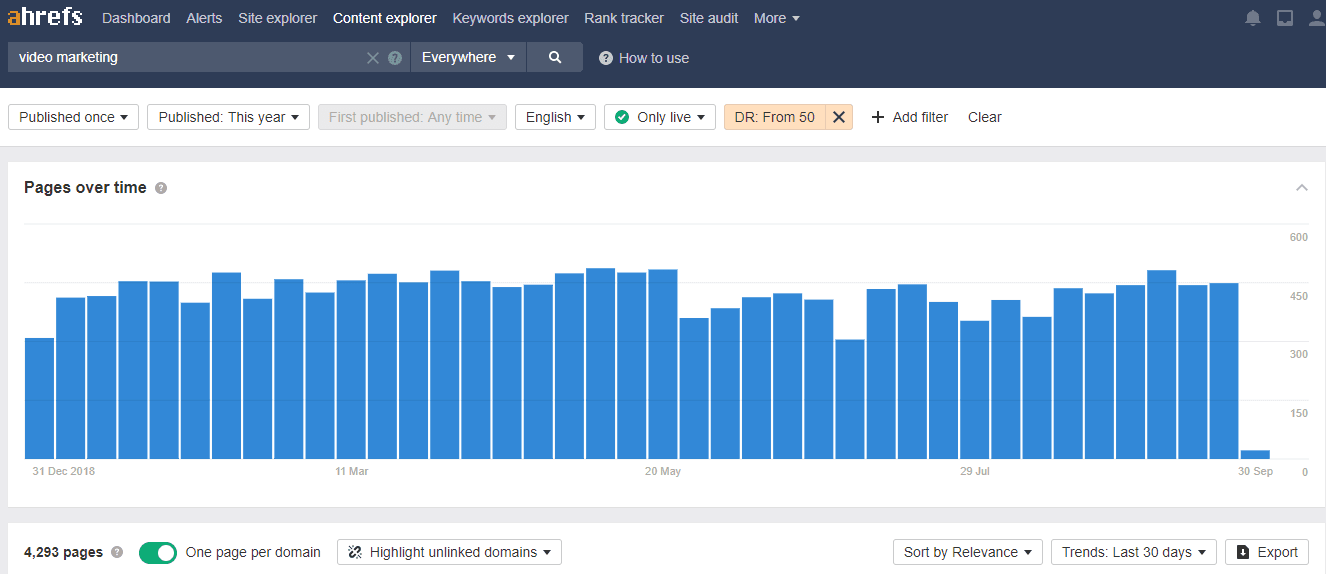 As you can see, this instantly cuts down results to about 4,000 pages, or about a third of the results without the DR filter. This instantly saves me time pitching publications that won’t be of much value to me.
Using the Google search method earlier described, or the Ahrefs Content Explorer, you can easily come up with a list of as many publications as you’d like that you can submit your guest post to.
As you can see, this instantly cuts down results to about 4,000 pages, or about a third of the results without the DR filter. This instantly saves me time pitching publications that won’t be of much value to me.
Using the Google search method earlier described, or the Ahrefs Content Explorer, you can easily come up with a list of as many publications as you’d like that you can submit your guest post to.
Step 2. Analyzing Publications to Ensure Content Fit
Once you’ve compiled a list of publications you can guest blog on, the next step is to actually analyze the publication to ensure content fit. This step is one of the most important, because it is the step that actually ensures you get published; and it is at this stage that many people go wrong. Getting it right will result in a higher percentage of your guest posts getting published. What do I mean when I talk about analyzing publications to ensure content fit? Let’s start by analyzing this particular guest post you’re reading. What made me pitch this particular idea to the CoSchedule blog? It’s quite simple, CoSchedule is a marketing suite that focuses on helping marketers organize and plan their content more effectively. Naturally, an article that focuses on the nitty-gritty of any aspect of content marketing is likely to work. Secondly, a clear analysis of articles published on the CoSchedule blog (articles by Ben Sailer in particular!) tend to be detailed, comprehensive, and visual. Generally, they include step-by-step information accompanied by screenshots. With this understanding, an article that is the “ultimate guide to guest blogging” will naturally be instructive, include a lot of steps, and contain a lot of screenshots. Pitching something like this is highly likely to be accepted. Based on a clear analysis of the CoSchedule blog, I can determine the following:- They want articles to be detailed and comprehensive; to essentially be the ultimate guide on a topic.
- They want articles to be instructive and step-by-step.
- They want articles to include relevant graphics and screenshots.
- When possible, they prefer articles to be from an angle demonstrating a writer has experience with what is being discussed.
 Further analysis of the Entrepreneur homepage shows a similar pattern: how to content tends to dominate. When a disproportionate amount of content is “how to” focused, you realize (even in the absence of a contributor’s guidelines) that the publication prefers how to content.
A further look at Entrepreneur.com shows that they do not just want how to articles, they want how to articles from a perspective that helps users achieve entrepreneurial success.
At the time I wanted to contribute to Adweek, I also used a similar approach. An analysis of the section of the site I was interested in contributing to reveals an emphasis on social media-related content from a unique perspective. I sent my pitches based on this understanding and was able to make sure my pitches were relevant:
Further analysis of the Entrepreneur homepage shows a similar pattern: how to content tends to dominate. When a disproportionate amount of content is “how to” focused, you realize (even in the absence of a contributor’s guidelines) that the publication prefers how to content.
A further look at Entrepreneur.com shows that they do not just want how to articles, they want how to articles from a perspective that helps users achieve entrepreneurial success.
At the time I wanted to contribute to Adweek, I also used a similar approach. An analysis of the section of the site I was interested in contributing to reveals an emphasis on social media-related content from a unique perspective. I sent my pitches based on this understanding and was able to make sure my pitches were relevant:
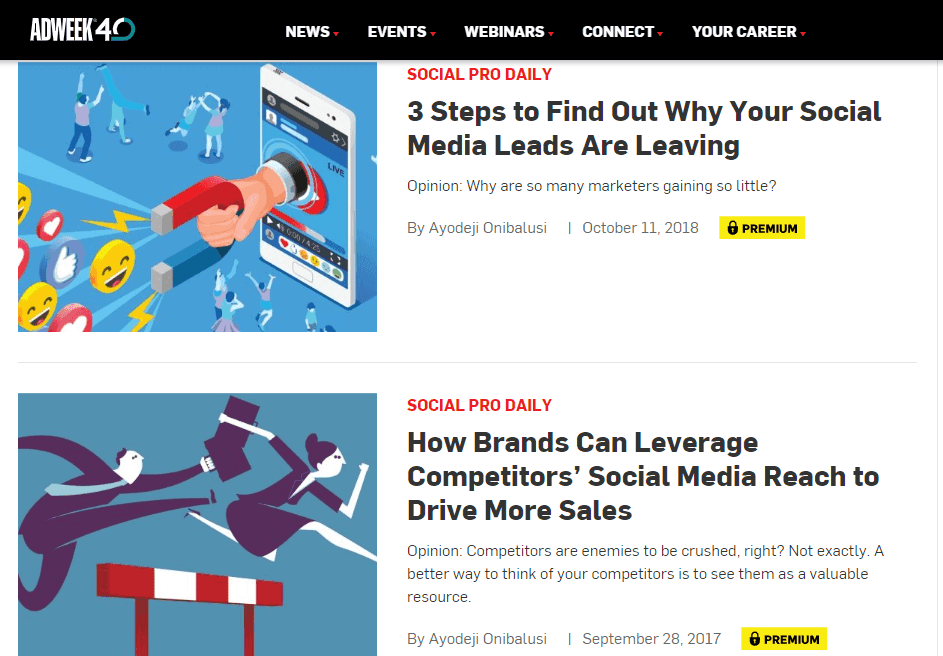 Sending content related to inbound marketing, or content marketing, in this instance might have negatively impacted my chances of being published.
In a nutshell, to ensure content fit before pitching a publication you want to do the following:
Sending content related to inbound marketing, or content marketing, in this instance might have negatively impacted my chances of being published.
In a nutshell, to ensure content fit before pitching a publication you want to do the following:
- Carefully analyze the publication to see what kind of content is in favor with the editors; is it how to? case studies? ultimate guides? or content that contains a lot of screenshots? Your content should take this format, too.
- Pay careful attention to the topic that a publication prefers; often, it’s possible to ensure the content ties in to the topic of your business. Sometimes, particularly with really large publications, it is impossible. It is important that your content align with what the publication prefers.
- More importantly, pay careful attention to the type of content published from other guest bloggers; an editor has the final say and can himself/herself write anything even if it is not related to what the blog covers. It’s highly unlikely that it will be the same for other guest contributors, however. Carefully analyze the type of guest posts published by other guest contributors; since these have been vetted, it should give you an idea of what will go through with a publication.
Step 3. The Art of the Pitch: Crafting Irresistible Pitches that Get Editors to Like You
Your first step to securing a guest post opportunity with any serious publication you want to write for is crafting a simple, straightforward pitch. Pitching your story to a blog or publication takes art and, dare I say, a bit of psychology. When composing your message, you want to make sure that every word that goes into your message serves a purpose. For me, pitches that are simple, quick, and straightforward are what works best. Editors are busy. They want to go to the next pitch in the list of probably 100 pitches they receive every day as soon as possible, so spending time on a lengthy pitch is not a profitable use of their precious time. Here’s a quick breakdown of the example pitch that got me published on Entrepreneur: In the sample pitch that got me into Entrepreneur, let's analyze what went into the message.
In the sample pitch that got me into Entrepreneur, let's analyze what went into the message.
- Get the subject line right: First of all, the subject line is short and straightforward. I spend the most time on my email subject line because it's what will determine my fate with the host. Here, it tells the recipient what to expect so they know what the rest of the message will be about before opening it.
- Keep the message short and simple: The second important thing is to keep your pitch very simple, short and straight to the point. Even if your article is not going to get accepted, you want to show that you care about and value their time. An editor would be willing to give constructive feedback if you show them that you value their time.
- Include a basic idea of what your article will be about: You want to make sure you include a basic idea of what your article will be about in the body of the pitch. You don’t want to paste the entire article in the email, or bore the editor with details, but there should be enough information to help make it easy for the editor to decide.
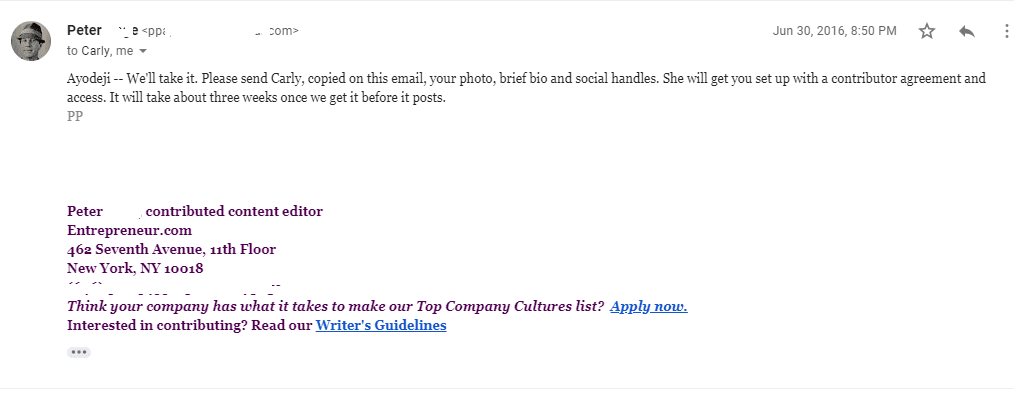 A similar approach was used in the pitch that helped me get published on The Balance (formerly About.com) as you can see below:
A similar approach was used in the pitch that helped me get published on The Balance (formerly About.com) as you can see below:
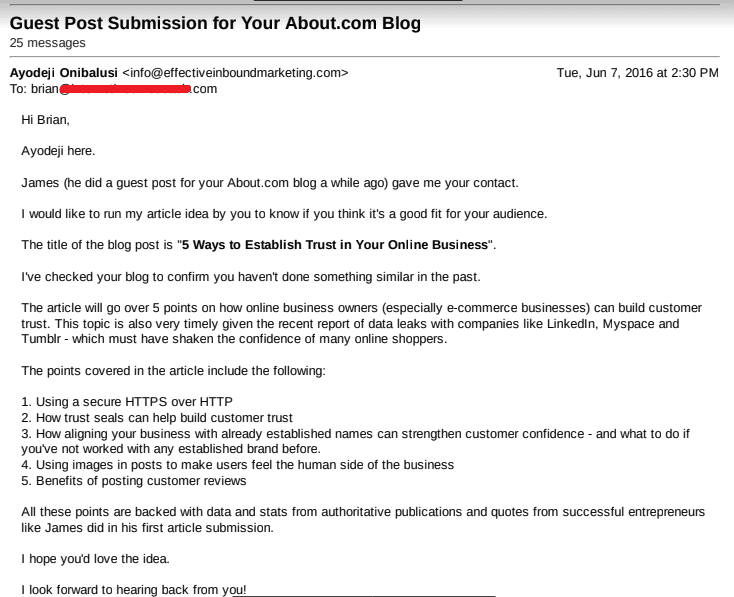 It’s not rocket science. While you probably expected something more complicated, it is really that simple.
With a small but:
You want to make sure you are emailing the actual editor who will be making content-related decisions and you want to make sure that your email to the editor is personalized.
It’s not rocket science. While you probably expected something more complicated, it is really that simple.
With a small but:
You want to make sure you are emailing the actual editor who will be making content-related decisions and you want to make sure that your email to the editor is personalized.
Step 4. Following Up: How to Send Follow Ups that Increase Your Chances of Publication
In a lot of cases, the editor would not respond to your first email pitch. This is where knowing how to properly follow up can make a lot of difference. Follow-ups should serve the purpose of calling the attention of the editor of the blog/publication to your earlier message and compel them to get back to you with a decision. When done right, a good follow-up can turn an otherwise dead lead into a new opportunity to get your guest post published. It's an opportunity to revive a relationship with the lead and chase your goals. But in most cases, inexperienced marketers will equally mess up a follow-up and kill every chance they'd have gotten to get published. Don't make that mistake. There are a few critical factors that go into the perfect follow-up, and I'll be sharing them with you: Timing: Timing is everything when you've lost the first opportunity to get their attention. Use timing to make sure your follow-ups do not end up getting ignored like your first email. Studies have shown that Tuesdays through Thursdays are the best days to send emails, generally. The perfect time of the day to send your follow-up? The answer is 8am to 10am. Since the first thing people do at the dawn of the day is to read their emails, hitting their inbox early in the morning guarantees it's seen. And what's more, the stress of the day is yet to wear them down, which means they're in a better mood. For the perfect time to send your emails, read this CoSchedule blog post by Nathan Ellering. Urgency: Infuse some urgency in your follow-up emails. You don't want to give the editor a reason to say "I'd get back to this email later!". No, they won't. Nobody ever does. Rather, you want them to say, "Gosh! Why did I miss this earlier?" and reply to you telling you how to move ahead. Right frequency: How much gap should you leave between follow-ups? Common consensus is to wait till the next seven days before sending a follow-up. But according to findings by Yesware (from studying 500,000 sales emails), if your email will ever get a response, 91 percent of the time, it'll be opened within a day after sending it. If that's the case, why wait for 7 days and leave your fate to chance? I'd say send a follow-up if you do not get a response in two days. Another follow-up can be done the Tuesday of the following week. To ensure your follow-ups deliver results, you can also use tools to aid your efforts. Tools can help you in several ways, such as nudging you to send a follow-up to a pitch that didn't get a response, setting a follow-up time and scheduling your follow-up emails. To help you, below are tools/add-ons I recommend:- Yesware: for tracking your emails and creating templates you can easily modify in similar circumstances.
- Mailtrack: for tracking your email opens.
- Google's email Schedule: for scheduling your email to go live hours, days, weeks, or months later even if you’re not logged in to your email account.



